
free shipping on orders over $25
We’re having a sale on all our products. Enter your email below to be notified about future sales.


We’re having a sale on all our products. Enter your email below to be notified about future sales.

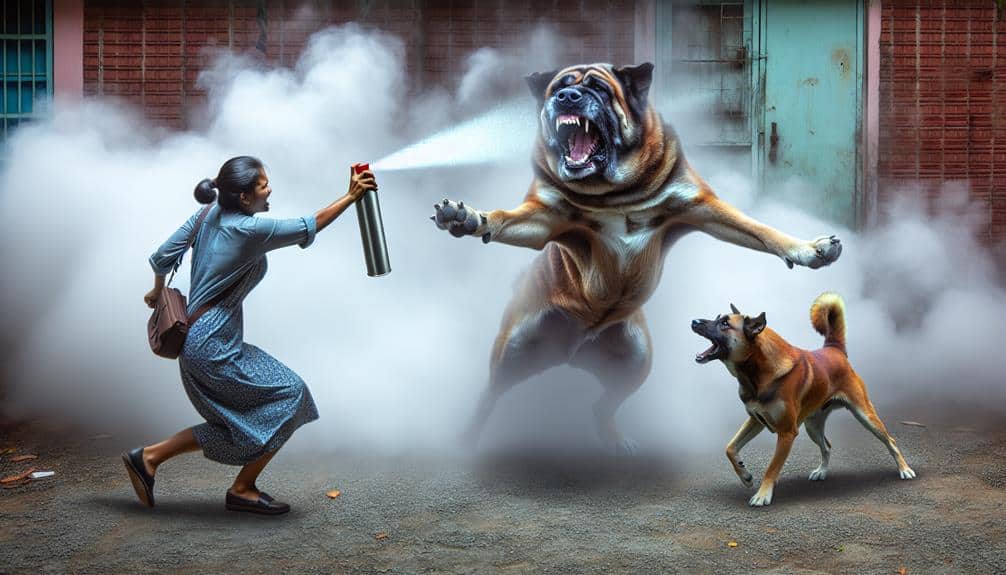
Facing an aggressive dog can be terrifying, but pepper spray might just be your lifesaver. Imagine a big, snarling dog lunging—panic sets in. With a quick spray, that pup will retreat fast, its eyes and nose burning like crazy. The University of Utah found these sprays ace at stopping dog attacks. Don’t get fooled by a wagging tail—it’s not always friendly. Cone sprays like MACE® Canine are super potent with a good range, perfect for a split-second defense. Keep calm, use your spray, and you’ll likely stay safe. And, who knows, you might pick up some more handy tips…
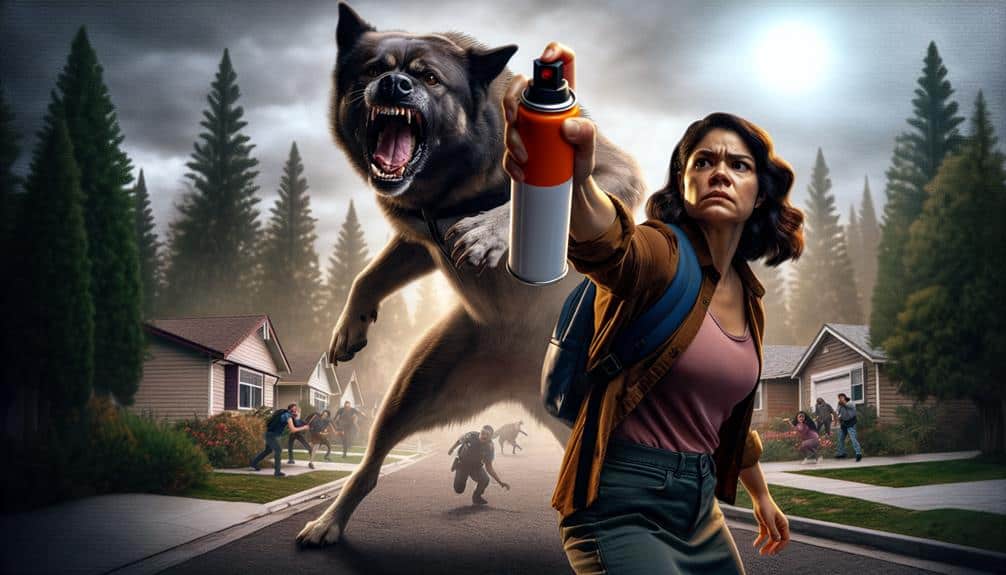
Pepper spray is a proven tool for deterring dog attacks, offering varying levels of potency based on the specific product. Imagine you’re out for a peaceful walk, and suddenly an aggressive dog charges at you. Your heart races, your palms sweat—it’s a terrifying moment. That’s where pepper spray comes to the rescue.
Different types of pepper sprays, like gel, stream, foam, or Wildfire, pack varying punches against aggressive dogs. For instance, MACE® Canine boasts a modified cone pepper spray that’s super potent, making it a top pick for warding off a dog attack. A University of Utah study even shows how commercial pepper sprays can effectively stop these scary encounters.
Of course, you should use pepper spray as a last resort, sparing it for those moments when you’re at risk of being bitten. It’s like having a superhero gadget in your pocket, ready to save the day.
The spray creates an intense burning sensation in the dog’s eyes and nose, making it back off. So, next time you’re out and about, armed with pepper spray, you can feel a bit more secure knowing you’ve got a reliable defense against those sudden, aggressive dog threats.
Recognizing the nuances of dog behavior is key to effectively managing and preventing aggressive encounters. Dogs can be unpredictable, especially when they’re feeling threatened or scared. You might see a dog’s body stiffen, ears pinned back, or teeth bared—these are clear warning signs. But remember, not all dogs will give obvious clues.
Owners often misjudge their own dog’s behavior during tense moments, so always exercise caution. Dogs, like humans, can have mood swings. One moment they’re calm, and the next, they might be aggressive. It’s vital to stay alert and adapt quickly to the dog’s changing signals.
Here’s a handy table to help you understand some common dog behaviors:
| Behavior | Description | Action to Take |
|---|---|---|
| Stiff body | Dog’s body becomes rigid | Don’t approach, stay calm |
| Ears pinned back | Ears flat against the head | Avoid direct eye contact |
| Bared teeth | Showing teeth, may growl or snarl | Slowly back away |
| Wagging tail | Tail wagging, but stiffly | Assess overall body language |
It’s important to handle every encounter with care and awareness. Understanding these behaviors can make a huge difference in staying safe and avoiding a potential attack. Your vigilance and adaptability are your best tools.
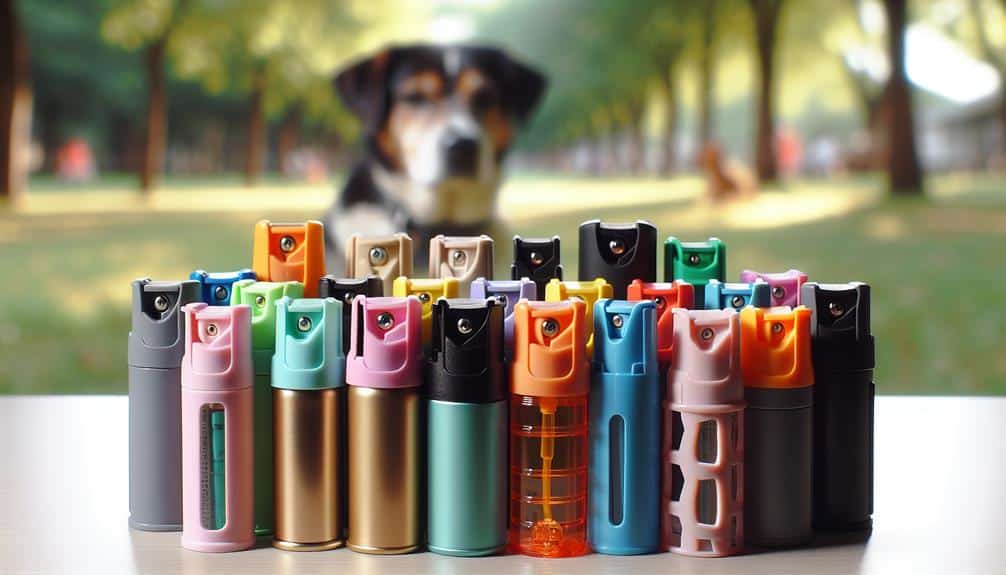
Understanding dog behavior is crucial in preventing attacks. Knowing the types of pepper spray available can better prepare you for an unexpected encounter. Selecting the most suitable spray for your needs is essential.
Here are four types of dog sprays to consider:
Choosing the correct dog spray can be the difference between a near-miss and a severe bite.
You won’t believe how many people have shared their pepper spray success stories! From a retired marine stopping a mountain lion to a customer scaring off a black bear, these accounts are nothing short of heroic.
Let’s hear from folks who’ve faced dog attacks head-on and lived to tell the tale, thanks to their trusty MACE® Canine.
Countless personal testimonials highlight how pepper spray has quickly and efficiently prevented potential dog attacks. Imagine walking your dog in the park, and suddenly, an aggressive dog charges at you. That’s precisely what happened to one customer who used pepper spray to stop the attack in its tracks.
Here are some real-life success stories:
These stories aren’t just anecdotes; they’re proof of pepper spray’s reliability. So next time you’re out for a walk and spot a potentially aggressive dog, remember that a quick spray could save you from a terrifying encounter.
Frequently, personal testimonials highlight the life-saving effectiveness of pepper spray in real-world dog attack scenarios. Imagine walking your usual route when, out of nowhere, an aggressive dog charges at you. Your heart races, your palms sweat, but you remember you’ve got your trusty pepper spray.
Take it from a retired marine and LAPD officer who once faced a mountain lion. He successfully stopped the attack with pepper spray. If it works on a mountain lion, it can surely handle aggressive dogs.
Another customer scared off a black bear, proving its worth beyond just dogs.
Yet, the most relatable stories come from everyday folks who’ve faced frightening dog attacks. One person shared their experience of a dog lunging at them during a morning jog. With a quick spray, the dog yelped and retreated, leaving the jogger safe and sound.
These testimonials often mention the MACE® Canine, a popular pepper spray, noting its reliability in such tense moments.
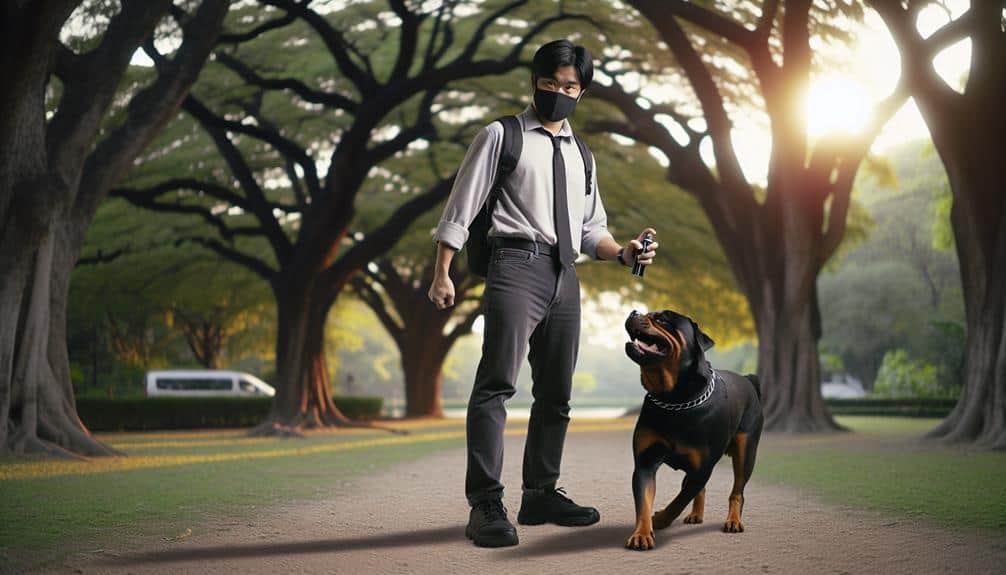
When using pepper spray against a dog attack, you’ve got to stay sharp and follow some key safety measures.
First, make sure you’re using the spray effectively by creating distance and aiming carefully—you don’t want to miss!
Also, keep a close watch on the dog’s body language to know when to act, and remember to contact animal control right after for everyone’s safety.
To guarantee your safety, always keep your eyes on the dog to monitor its behavior and reactions. Using pepper spray can be a lifesaver, but you’ve got to know how to use it effectively.
Here’s a quick guide to make sure you’re prepared:
If the situation escalates, don’t hesitate to seek help or contact animal control immediately. Remember, it’s not just about defending yourself but also about preventing further harm.
Stay safe, stay alert, and if all else fails, that pepper spray will be your best friend in a pinch.
Understanding dog body language is essential for identifying potential threats and ensuring your safety. Dogs communicate a lot through their body, and recognizing these signals can make all the difference.
You might see a dog growling, baring its teeth, or with raised fur—these are clear red flags. But don’t be fooled by a wagging tail; it doesn’t always mean the dog is friendly. A wagging tail can also mean the dog is stressed, excited, or even aggressive.
Pay close attention to more subtle cues like direct eye contact, ears pinned back, or a stiff, tense body. These signs can indicate that a dog is feeling threatened or ready to attack.
If you notice any of these behaviors, it’s time to get your pepper spray ready. You’re not looking to harm the dog but to protect yourself.
Maintaining a safe distance after using pepper spray on an aggressive dog is crucial to prevent further confrontation. The last thing you want is to turn your back on the attacking dog and find out it’s still in fight mode. So, keep your eyes peeled and follow these steps to guarantee your safety:
Acting cautiously and staying vigilant can make all the difference. Picture yourself as a statue—steady and unyielding—until the danger passes.
And remember, you’re not alone in this; help is just a phone call away. Your safety is the priority, so keep calm and stay smart!
Carrying self-defense tools like pepper spray can make all the difference in preventing or managing dog attacks. Imagine you’re out for a peaceful walk, and suddenly an aggressive dog approaches. Having pepper spray handy could be your best line of defense, giving you a chance to deter the animal without causing long-term harm.
It’s not just about having it; how you carry it matters, too. Investing in a belt holster guarantees you can grab it quickly when you need it most.
Pairing pepper spray with a gun might sound essential, but in cases of severe attacks, it’s important to have multiple options. For most situations, though, non-lethal methods are the way to go. Bear spray, for instance, isn’t just for bears; it’s incredibly effective against dogs and other wildlife threats, giving you a broader safety net.
Self-defense isn’t just about the tools; it’s about being prepared. Carrying a walking stick could also help, serving as both a deterrent and a barrier.
In the end, it’s about creating a safer environment for yourself without escalating the situation. So, gear up and stay safe out there!
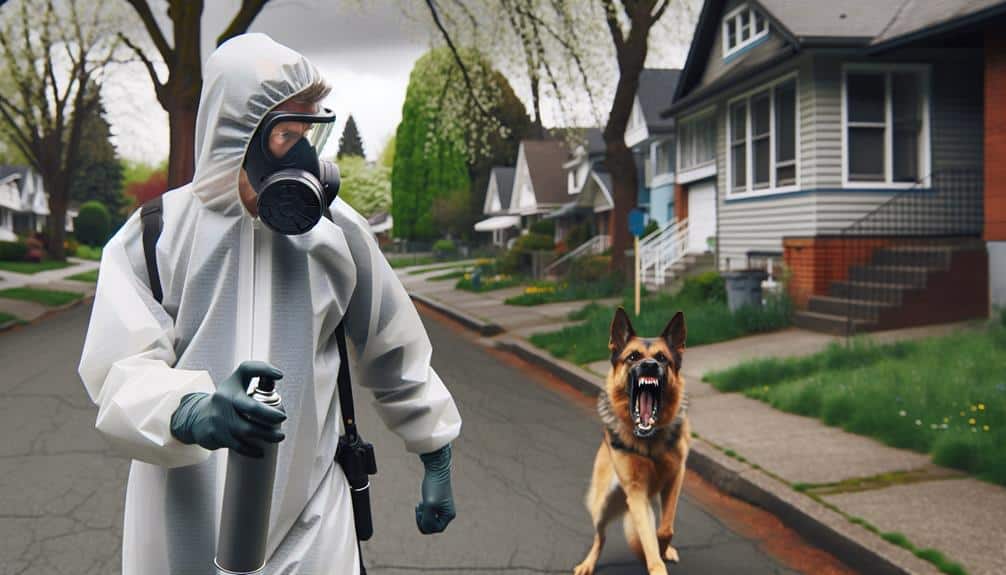
Equipping yourself with protective gear can greatly reduce the risk of injury during a dog attack. Imagine you’re taking a peaceful walk, pepper spray in hand, when suddenly an aggressive dog charges at you. Having the right gear can make all the difference.
Here are some essential items you should consider:
Now, let’s not forget about our furry friends. For your small dog, consider coyote-resistant vests or thick canvas collars to protect their necks. Spikes for dog coats and tactical vests can also deter aggressive animals.
While pepper spray is a fantastic first line of defense, combining it with protective gear ensures you and your pet stay safe. It’s like having a superhero suit—ready to fend off any unexpected danger.
Having the right protective gear is important, but being prepared with practical tips can make a significant difference in preventing dog attacks. Always carry pepper spray formulated specifically for dogs when you’re out and about. It’s a small, handy tool that can save you from a scary situation. Stay alert and be ready for any unexpected dog encounters. You don’t want to be caught by surprise!
Keep your self-defense tools, like pepper spray, easily accessible. Fumbling around in your bag while an aggressive dog approaches isn’t ideal. Make sure you know how to use it correctly, and always be cautious of the wind direction when spraying. You don’t want the pepper spray blowing back at you!
Also, having a warm coat nearby can be a lifesaver. If a dog does attack, it can help shield you from bites. And always, always watch out for signs of rabies in animals. Foaming at the mouth and erratic behavior are big red flags.
Being prepared doesn’t mean being paranoid. It just means you’re smart and ready. With these tips, you’ll be more confident and safe on your outdoor adventures. Happy exploring!
Yes, pepper spray will stop a dog from attacking you. In effectiveness comparison, it causes irritation to the dog’s nose, eyes, and skin, providing a humane, short-term solution and allowing you a safe escape.
The best deterrent for dog attacks is pepper spray, specifically D.A.D.® 2. Unlike dog whistles, pepper spray immediately stops aggressive behavior and is humane and non-lethal, making it highly effective in protecting yourself.
Yes, pepper spray can work in a dog fight by incapacitating the aggressive dog. However, it’s important to rely on training techniques first and use pepper spray only as a last resort for personal safety.
Yes, pepper spray for humans works on dogs. Remember, there are legal considerations. Always check local regulations before using it on dogs, ensuring it’s a humane and temporary deterrent that won’t cause permanent harm.
Para Bellum Defense
133 Palm Drive
Winter Haven, FL 33880
Telephone: 585-284-6669

2 Responses